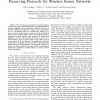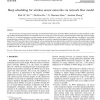36 search results - page 5 / 8 » A pragmatic approach to area coverage in hybrid wireless sen... |
SENSYS
2006
ACM
14 years 1 months ago
2006
ACM
Varying interference levels make broadcasting an unreliable operation in low-power wireless networks. Many routing and resource discovery protocols depend on flooding (repeated pe...
JUCS
2008
13 years 7 months ago
2008
: Wireless Sensor Networks (WSN) allow, thanks to the use of small wireless devices known as sensor nodes, the monitorization of wide and remote areas with precision and liveness u...
HYBRID
2009
Springer
14 years 2 months ago
2009
Springer
In this paper, we analyze the problem of finding a periodic schedule for the wake-up times of a set of nodes in a Wireless Sensor Network that optimizes the coverage of the region...
ISCAS
2005
IEEE
14 years 1 months ago
2005
IEEE
Abstract— The wireless sensor network is an emerging technology that may greatly facilitate human life by providing ubiquitous sensing, computing, and communication capability. H...
COMCOM
2006
13 years 7 months ago
2006
The pervasiveness and operational autonomy of mesh-based wireless sensor networks (WSNs) make them an ideal candidate in offering sustained monitoring functions at reasonable cost...


